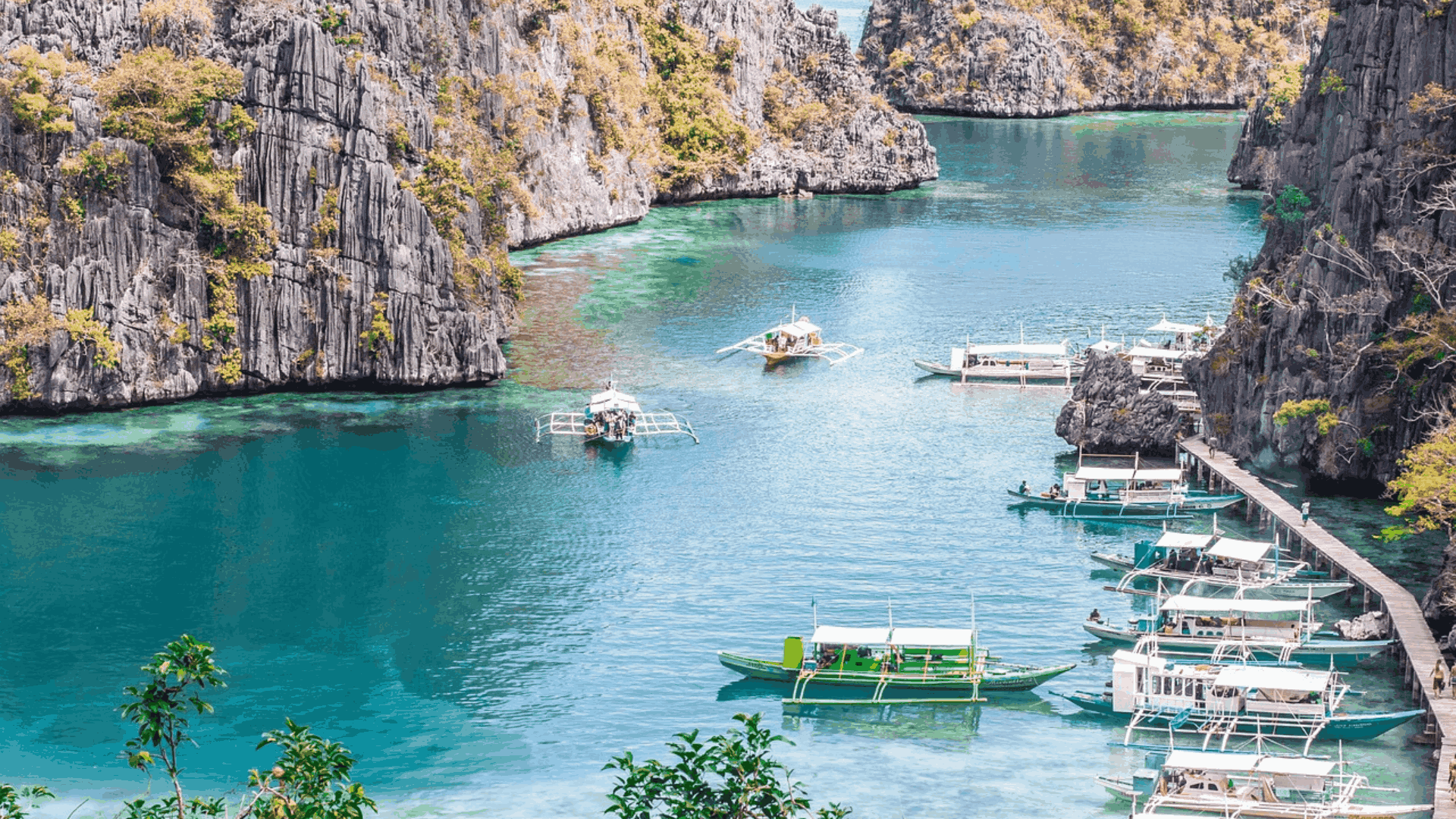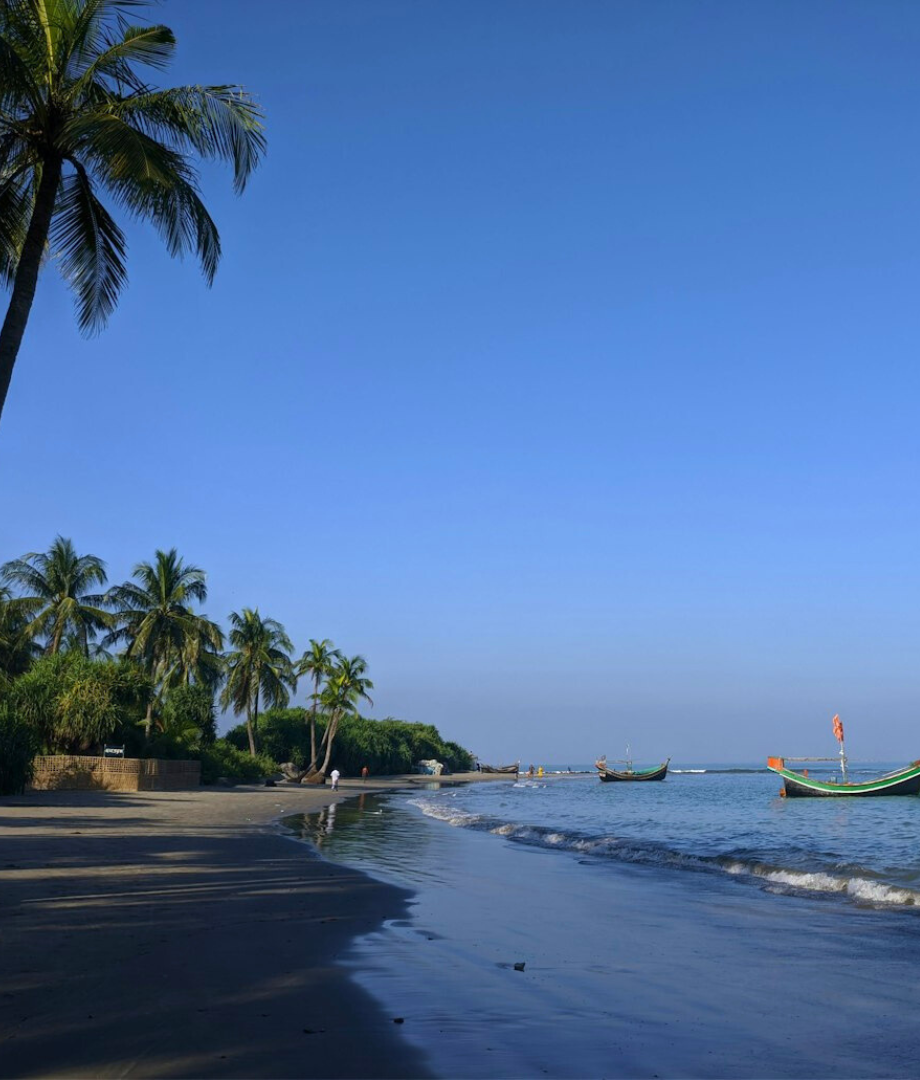Discover the Top Tourist Destinations in the Philippines
Wondering where to go in the Philippines? Start your day at the beautiful Taal Volcano in Batangas for a scenic sunrise. Then, head to Tagaytay for a relaxing lunch with views of the volcano and Lake Taal. Finish the day with a sunset at the stunning Pagsanjan Falls, just a short drive away.
But if you're looking for a list of places to visit in the Philippines, welcome to this travel guide.
The Philippines is home to 100 active volcanoes, 7,600 islands, 30,000 kilometers of coastline. Its cultural roots span Malay, Spanish, and Austronesian heritage. So, clealry, Philippines is more than just beaches. It is home to many attractive tourist spots.
Let's get to know about the best places that this country has to offer!
Philippines’ Top Beaches & Islands
Palawan
Location: Southwest of Luzon, Palawan Province, Philippines.
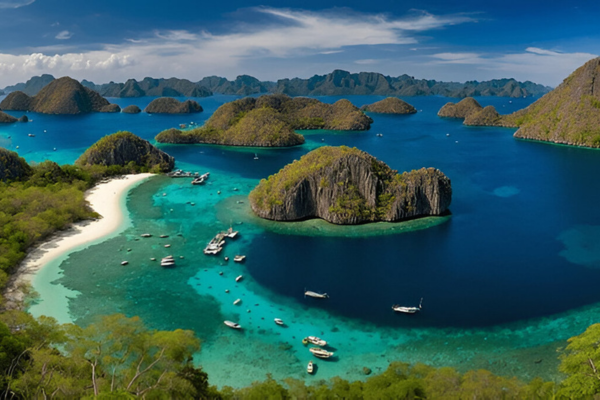
Palawan is one of the most sought-after island destinations in the Philippines. Known for its crystal-clear waters, dramatic limestone formations, and thriving marine ecosystems, Palawan offers diverse experiences across key locations. For example, El Nido features towering karst cliffs and turquoise lagoons ideal for kayaking and snorkeling, while Coron attracts wreck divers to its World War II-era sunken ships. Puerto Princesa’s Subterranean River National Park, a UNESCO World Heritage Site and New 7 Wonders of Nature entry, offers guided boat tours through cave chambers filled with stalactites and bat colonies. These features position Palawan among the most memorable Philippines tourist attractions for beach lovers, nature seekers, and adventure travellers.
Boracay
Location: Northwest of Panay Island, Aklan Province, Western Visayas, Philippines.
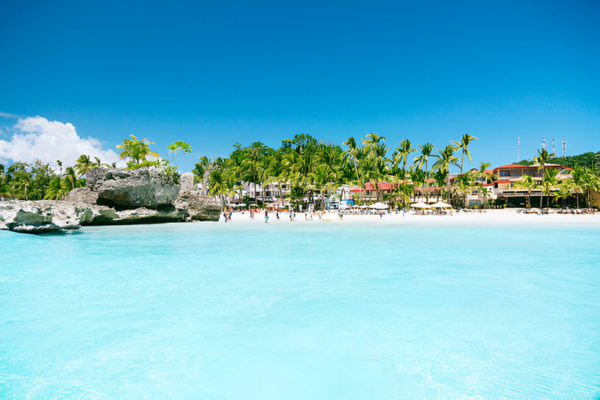
Boracay remains one of the top places to visit in the Philippines, anchored by its four-kilometer White Beach—renowned for powdery sand and turquoise waters. Following major environmental rehabilitation, the island now operates under strict sustainability guidelines, balancing tourism with ecological protection. Regulated activities include paraw sailing at sunset, paddleboarding, and snorkeling, while beachfront areas host nightly fire shows and curated local dining. Boracay’s transformation from an overdeveloped hotspot to a model of responsible tourism reinforces its position among the must-visit spots for travellers seeking both leisure and environmental consciousness in a tropical island setting.
Siargao
Location: Off the northeastern coast of Mindanao, Surigao del Norte, Philippines.
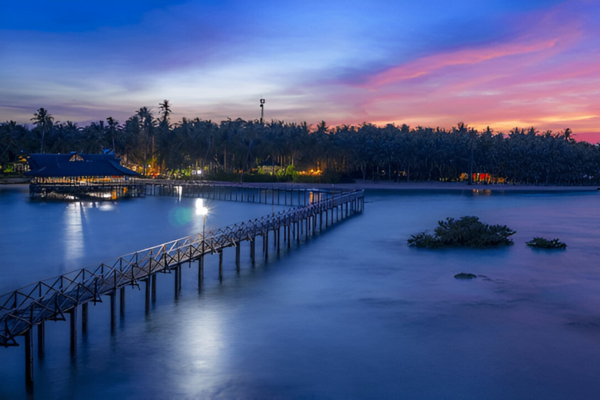
Siargao stands out as one of the best-rated places in the Philippines for travellers seeking both adventure and serenity. Globally recognised for Cloud 9, a world-class surf break, the island also features natural attractions like Sugba Lagoon—ideal for paddleboarding and kayaking—and the tidal Magpupungko Rock Pools, accessible during low tide. Beyond its surf culture, Siargao offers quiet beaches, island-hopping to nearby islets, and a relaxed atmosphere rooted in local community life. Its blend of adrenaline and calm makes it one of the leading sightseeing destinations of the Philippines. No wonder why beach enthusiasts, families, and nature-driven tourists love this island!
Camiguin
Location: North of Mindanao, Camiguin Province, Northern Mindanao, Philippines.
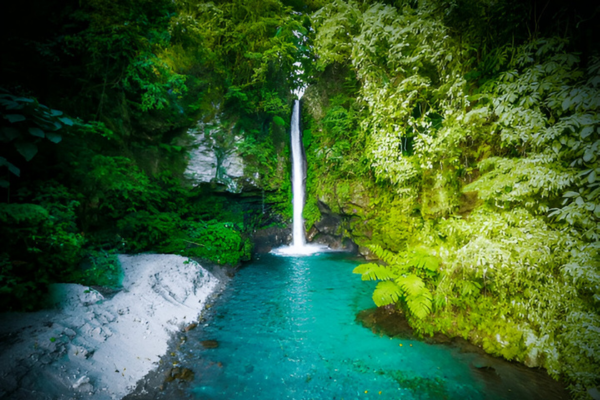
Camiguin, known as the "Island Born of Fire," is one of the most distinctive islands of the Philippines. It offers a rare blend of volcanic terrain, coastal beauty, and tranquil springs. Home to seven volcanoes, the island invites adventure seekers to trek Mount Hibok-Hibok, a protected area with panoramic summit views. Nature lovers can swim in Santo Niño Cold Springs, dive at sunken cemetery reefs, or sunbathe on the picturesque White Island sandbar just offshore. With its compact size, low tourist density, and rich geothermal features, Camiguin ranks among the most serene spots for eco-tourism, wellness retreats, and off-grid travel experiences.
Bantayan Island
Location: Northwest of Cebu Island, Cebu Province, Central Visayas, Philippines.
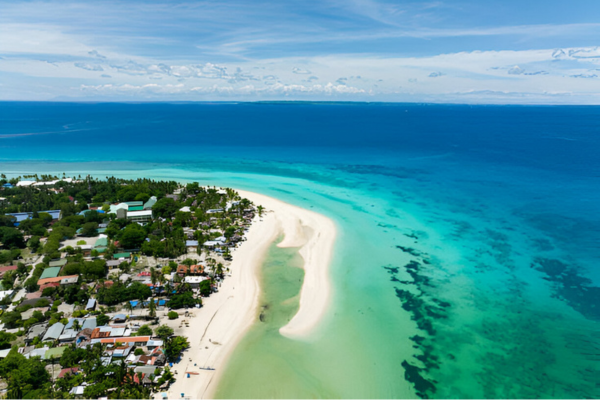
Bantayan Island in northern Cebu is a serene coastal destination and one of the most peaceful tourist spots of the Philippines. If you’re seeking uncrowded beaches and slow-paced island life, you should definitely visit here. Known for its powdery white sand, shallow turquoise waters, and dramatic limestone cliffs, Bantayan offers a quiet alternative to more commercialised tourist hubs. Visitors can explore Virgin Island on day trips, visit the centuries-old Sts. Peter and Paul Church in Bantayan town, or enjoy fresh seafood along the island’s relaxed beachfront eateries. Its raw charm, minimal crowds, and natural beauty make it a hidden gem among top Philippines tourist spots for beach and nature lovers.
Panglao
Location: Southwest of Bohol, Bohol Province, Central Visayas, Philippines.
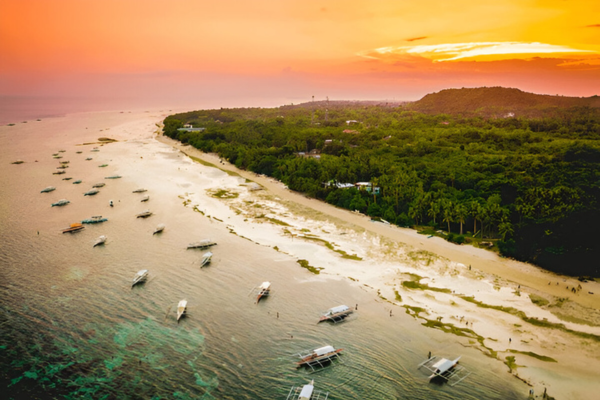
Panglao Island in Bohol is a top coastal destination and one of the most attractive places in the Philippines. It is ideal for marine adventure and beachfront relaxation. Alona Beach, the island’s main hub, offers direct access to vibrant coral reefs, dolphin-watching tours, and Balicasag Island—a protected marine sanctuary known for sea turtles, barracudas, and steep underwater walls ideal for diving. The island also features Hinagdanan Cave, where visitors can swim in a natural limestone pool. With well-developed tourist facilities, white-sand beaches, and biodiverse waters, Panglao ranks high in the list of Philippines’ attractions for snorkeling, scuba diving, and tropical getaways.
Interactive Map of Philippines' Best Beaches and Islands
Philippines’ Top Natural Wonders
Chocolate Hills
Location: Inland Bohol, Bohol Province, Central Visayas, Philippines.
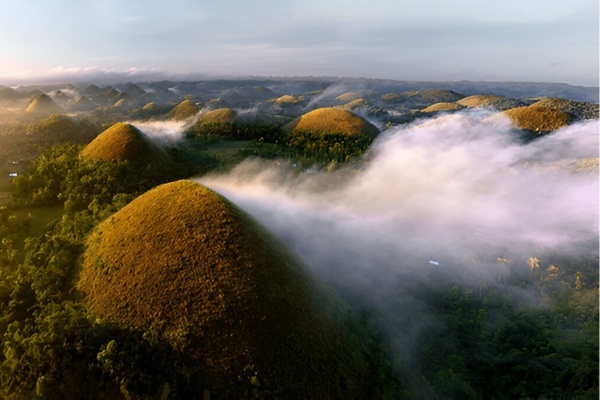
The Chocolate Hills in Bohol are one of the most unique geological formations and widely recognised natural attractions of the Philippines. Spanning over 50 square kilometers, more than 1,200 grass-covered limestone mounds turn chocolate brown during the dry season, creating a striking, uniform landscape. These dome-shaped hills are best observed at sunrise from the Carmen viewing deck, where early mist adds to their surreal appearance. The area draws interest from both geologists studying karst topography and travellers seeking scenic spots linked to local myths. As a protected natural monument, it remains a standout among Philippines tourist hotspots for its rarity and visual impact.
Mayon Volcano
Location: Southeastern Luzon, Albay Province, Bicol Region, Philippines.

Mayon Volcano in Albay combines danger with beauty. Known for its near-perfect cone shape, this 2,462 meter tall mountain dominates the skyline. It draws geologists, photographers, and adventure seekers alike. Visitors can take guided ATV rides across hardened lava trails, hike up designated routes during safe periods, or view the volcano from strategic points like Ligñon Hill and the Cagsawa Ruins—the latter preserving remnants of an 1814 eruption. As an active stratovolcano with a history of over 50 eruptions, Mayon combines geological significance with cultural depth, which makes it different from the rest of Philippines’ features.
Tubbataha Reefs
Location: Middle of the Sulu Sea, Cagayancillo, Palawan Province, Philippines.

The Tubbataha Reefs Natural Park, a UNESCO World Heritage Site in the Sulu Sea, ranks among the most ecologically significant places in the Philippines. Accessible only by liveaboard vessels during the March to June dive season, it spans over 97,000 hectares of protected marine area. The site supports over 600 fish species, 360 coral species, 13 shark species, and nesting sites for endangered sea turtles and seabirds. Known globally for exceptional coral integrity and biomass density, Tubbataha attracts expert divers seeking world-class marine sanctuaries. Its remote location and strict conservation rules help maintain its status as one of the top Philippines travel places for underwater exploration.
Mount Apo
Location: Between Davao and Cotabato, Davao Region, Mindanao, Philippines.

Mount Apo, the highest peak in the Philippines at 2,954 meters, stands as a premier destination for trekking enthusiasts and nature-focused travellers. Located between Davao and Cotabato, this stratovolcano is part of a protected natural park home to over 270 bird species, including the endangered Philippine eagle. Multi-day hikes traverse mossy forests, sulfur vents, and boulder trails, culminating at Lake Venado—one of the country’s highest lakes—nestled just below the summit. As one of the most challenging and rewarding places to visit in the Philippines, Mount Apo offers not only physical elevation but also deep immersion in biodiversity and cultural heritage.
Lake Sebu
Location: South Cotabato, SOCCSKSARGEN Region, Mindanao, Philippines.

Lake Sebu in South Cotabato is a next-level natural and cultural attraction of the Philippines, offering travellers both scenic landscapes and deep-rooted indigenous traditions. Surrounded by rainforest-covered hills, the lake features seven waterfalls and one of Southeast Asia’s highest ziplines, giving panoramic views of the valley. Visitors can interact with the T’boli community—an indigenous group known for their brasswork, music, and intricate T’nalak weaving made from abaca fibers dyed using sacred, centuries-old techniques. Cultural performances, museum visits, and guided village tours provide insight into their spiritual connection with nature. They way Lake Sebu bridges ecotourism and heritage is truly commendable.
Hundred Islands
Location: Off the coast of Alaminos, Pangasinan Province, Ilocos Region, Philippines.

The Hundred Islands National Park in Pangasinan is one of the most accessible and diverse natural destinations in the Philippines. Comprising 124 limestone islands during low tide, the park offers island-hopping tours that include snorkeling reefs, hidden coves, and white-sand beaches. Key islands like Governor’s Island, Quezon Island, and Marcos Island feature developed facilities, zipline platforms, kayaking routes, and cliff-diving sites. The area supports coral gardens and marine life ideal for beginner snorkelers and recreational divers. As a well-managed marine sanctuary, it appeals to both adventure seekers and families exploring top Philippines tourist attractions.
Interactive Map of Philippines' Best Natural Wonders
Philippines’s Top Cultural & Historical Sites
Intramuros
Location: Historic core of Manila, National Capital Region, Philippines.

Intramuros in Manila remains one of the most significant historical areas of the Philippines, offering travellers a concentrated glimpse into the country’s colonial past. Built in the late 16th century as the center of Spanish rule, the walled city preserves centuries of architectural and cultural heritage. Visitors can explore Fort Santiago, once a military stronghold and prison; San Agustin Church, a UNESCO World Heritage Site and the oldest stone church in the country; and Casa Manila, a recreated colonial mansion showcasing period furnishings and Filipino-Spanish lifestyle. As a cultural landmark, Intramuros is central to understanding the evolution of Philippine identity and stands out among essential Philippines tourist spots.
Vigan
Location: Northwestern Luzon, Ilocos Sur Province, Ilocos Region, Philippines.

Vigan in Ilocos Sur is one of the best-preserved Spanish colonial towns in Asia. It’s also a key cultural destination for travellers seeking historical places to visit in the Philippines. Recognised as a UNESCO World Heritage Site, it features cobblestone streets, ancestral houses, and Baroque architecture that date back to the 18th and 19th centuries. Visitors can ride calesas along Calle Crisologo, explore museums like the Syquia Mansion and Crisologo Museum, and witness traditional pottery-making in Pagburnayan. Unlike many heritage sites, Vigan remains a living town where locals continue their daily routines, offering an authentic and immersive experience among the best hotpots.
Banaue Rice Terraces
Location: Ifugao Province, Cordillera Administrative Region, Northern Luzon, Philippines.

The Banaue Rice Terraces in Ifugao are among the most iconic cultural landscapes and historic hotposts of the Philippines. Carved into the Cordillera mountains over 2,000 years ago using minimal tools, these UNESCO-inscribed terraces demonstrate advanced indigenous engineering adapted to steep terrain. Still cultivated by the Ifugao people, the terraces support rice and vegetable farming while preserving ancestral knowledge passed down through generations. travellers trekking through villages like Batad and Hapao encounter hand-built stone walls, gravity-based irrigation systems, and active farming communities. This living heritage site stands as a powerful symbol of sustainability, and a special place that is rooted in indigenous identity.
Corregidor Island
Location: At the entrance of Manila Bay, Cavite Province, Calabarzon, Philippines.

Corregidor Island in Manila Bay is a major historical destination in the and one of the most impactful sites in the Philippines for those interested in World War II heritage. Once a key military stronghold, the island now serves as an open-air war memorial featuring the Malinta Tunnel, which housed soldiers and civilians during Japanese bombardment, and the Pacific War Memorial, built to honor Filipino and American forces. Guided tours take visitors through barracks ruins, artillery batteries, and wartime hospitals, offering a sobering look at the country's wartime history. Corregidor delivers not just historical insight but emotional resonance, making it a standout among Philippines' sightseeing attractions.
Rizal Park
Location: Central Manila, National Capital Region, Philippines.
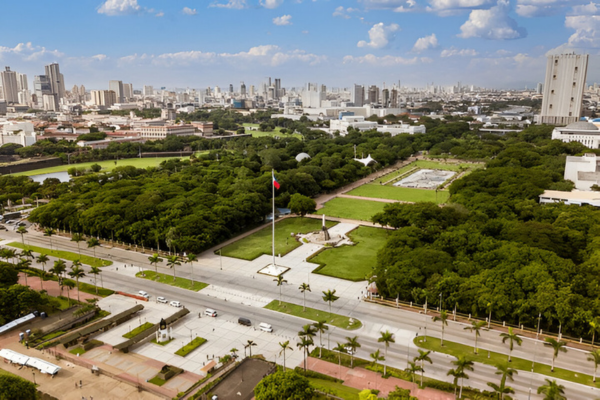
Rizal Park in Manila is a central historical landmark and one of the most accessible cultural places of the Philippines. Spanning over 58 hectares, it honors national hero Dr. José Rizal, whose monument marks the site of his execution in 1896—a pivotal moment in Philippine independence. The park serves multiple functions: a memorial site, civic gathering space, and open-air museum with dioramas, fountains, and gardens. It also hosts regular cultural performances and educational exhibits. So, Rizal Park is a popular spot for both local and international visitors exploring Philippines' national identity and historical memory.
Barasoain Church
Location: Malolos City, Bulacan Province, Central Luzon, Philippines.
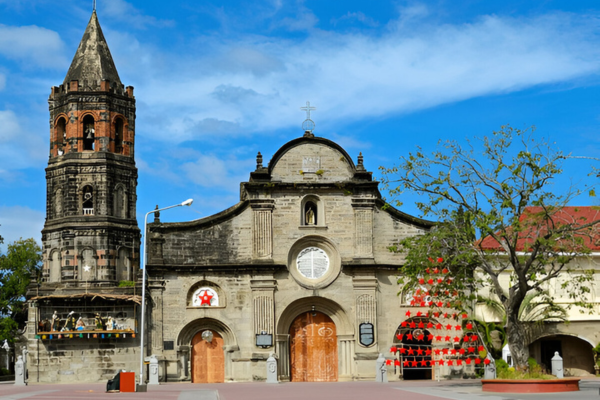
Barasoain Church in Malolos, Bulacan, is a pivotal historical landmark and a key cultural site in the Philippines. Known as the cradle of the First Philippine Republic, it hosted the First Philippine Congress in 1898, where the Malolos Constitution was drafted. The church features baroque architecture with ornate facades, stone carvings, and a heritage museum that contextualises its political significance. Located near the Malolos Cathedral and within reach of the Kakarong de Sili Shrine, Barasoain is part of a broader heritage trail that reflects the country's revolutionary past. It remains a must-visit for those seeking historically rich places in the Philippines.
Interactive Map of Philippines' Best Cultural & Historical Sites
Philippine’s Top Adventure & Outdoor Spots
Sagada
Location: Mountain Province, Cordillera Administrative Region, Northern Luzon, Philippines.

Sagada in Mountain Province is one of the most compelling places to visit in the Philippines for travellers seeking a mix of adventure, cultural heritage, and natural beauty. Famous for its mist-covered mountains and ancient burial practices, Sagada offers unique outdoor experiences such as spelunking in Sumaguing Cave, where visitors navigate limestone chambers and underground pools. Echo Valley’s hanging coffins reflect centuries-old Igorot burial traditions, adding cultural depth to scenic hikes. Kiltepan Viewpoint, popular for sunrise treks, reveals a sea of clouds over pine-covered ridges, creating moments of quiet awe. These features make Sagada a great destination in the Philippines for introspective and active travellers alike.
Mount Pulag
Location: Borders Benguet, Ifugao, and Nueva Vizcaya, Cordillera Region, Philippines.

Mount Pulag in Benguet is one of the most rewarding outdoor places in the Philippines, especially for hikers aiming to experience the country’s renowned “sea of clouds.” As Luzon’s highest peak at 2,926 meters, it draws trekkers to pre-dawn ascents where blankets of mist drift over pine forests and rolling ridges. The climb passes through distinct ecological zones—mossy forests, grasslands, and dwarf bamboo fields—supporting rare species like the dwarf cloud rat. Beyond its natural beauty, Mount Pulag holds cultural significance for indigenous communities who regard the mountain as sacred. It stands out among the best adventurous attractions for its ecological value and emotional impact on climbers.
Cebu Canyoneering & Kawasan Falls
Location: Badian, Cebu Province, Central Visayas, Philippines.

Canyoneering in Badian, Cebu is one of the most thrilling outdoor activities and a top contender among adventure-filled places in the Philippines. The route follows the Badian River to the multi-tiered Kawasan Falls, where travellers leap off 15-meter cliffs, navigate limestone gorges, and slide down smooth rock formations into turquoise plunge pools. Surrounded by dense tropical forest and freshwater streams, the experience combines physical challenge with striking natural scenery. This adrenaline-pumping journey appeals to thrill seekers and nature lovers alike, making it one of the most dynamic Philippines tourist attractions for those looking to explore the country's rugged, water-carved landscapes.
Donsol
Location: Sorsogon Province, Bicol Region, Southern Luzon, Philippines.

Donsol in Sorsogon is one of the most meaningful wildlife-focused areas in the Philippines, offering regulated, eco-friendly encounters with whale sharks—locally known as butanding. From November to June, visitors can join community-led boat tours where snorkeling alongside these gentle filter feeders is guided by strict conservation protocols. Unlike commercial feeding sites, Donsol promotes natural interaction, ensuring minimal disruption to the animals. The adventurous experience combines marine biodiversity education with the thrill of swimming beside creatures that can reach up to 12 meters in length, which makes Donsol a great place for ethical nature experiences.
Mount Pinatubo
Location: Zambales-Tarlac-Pampanga border, Central Luzon, Philippines.

Mount Pinatubo in Zambales is one of the most dramatic volcanic landscapes and a unique choice among adventure-focused travellers. Formed after the 1991 eruption, its vast caldera now holds a striking turquoise crater lake surrounded by ash-gray cliffs. Reaching the summit involves a combination of 4x4 rides across lahar fields and a guided trek through rugged terrain, offering views of barren valleys shaped by pyroclastic flows. The trail leads to a quiet, wind-swept rim where travellers take in the surreal contrast between geological destruction and natural renewal. Thus, Mount Pinatubo became one of the best tourist spots in the Philippines for its raw, otherworldly beauty and geological significance.
Cagayan de Oro
Location: Misamis Oriental, Northern Mindanao Region, Philippines.

Cagayan de Oro in Northern Mindanao is widely regarded as the whitewater rafting capital of the Philippines and a top destination for outdoor thrill-seekers. The Cagayan de Oro River features a 22-kilometer stretch of class II to class IV rapids, offering adrenaline-filled runs suitable for both beginners and experienced paddlers. Certified guides, safety gear, and orientation sessions ensure accessibility even for non-swimmers. Surrounded by lush forest and rugged canyons, the rafting experience blends teamwork, scenic landscapes, and high-energy adventure, making Cagayan de Oro an exceptionally good destination for active travellers.
Interactive Map of Philippines' Best Adventure and Outdoor Spots
Philippines’ Top Nightlife Spots
Boracay
Location: White Beach, Malay, Aklan Province, Western Visayas, Philippines.

Boracay remains one of the most vibrant nightlife spots in the Philippines for travellers seeking beachside entertainment after dark. The island’s nightlife centers around White Beach, where venues like Epic Boracay, Exit Bar, and Prisma offer beachfront parties, live DJs, and signature cocktails under the stars. Fire dancing shows light up the sand, while themed events and curated music sets attract both locals and international guests. Since its environmental rehabilitation, Boracay’s party scene has shifted toward a more refined atmosphere—balancing lively energy with sustainability—making it one of the most dynamic Philippines tourist spots for nightlife enthusiasts.
Poblacion
Location: Makati City, National Capital Region, Philippines.

Poblacion in Makati is one of the most dynamic urban places to visit in the Philippines for travellers seeking authentic nightlife and creative street culture. Known for its gritty charm and indie appeal, this former red-light district has transformed into a hub of food stalls, speakeasies, art bars, and rooftop lounges. Popular spots like Agimat, Z Hostel Roofdeck, and Commune attract a mix of locals, backpackers, and creatives, offering everything from craft cocktails to live music and poetry nights. Poblacion’s unpolished energy, walkable alleys, and diverse crowd make it a standout among Philippines' attractions for those looking to experience Manila’s cultural edge after dark.
BGC (Bonifacio Global City)
Location: Taguig City, Metro Manila, National Capital Region, Philippines.

Bonifacio Global City (BGC) in Taguig is a premier destination for upscale nightlife and urban hotspot in the Philippines. Known for its modern infrastructure, walkable streets, and secure environment, BGC offers a polished nightlife scene with high-end bars, rooftop lounges, and entertainment hubs. The Palace complex, home to mega-clubs like Yes Please, Xylo, and Revel, anchors the area’s after-dark appeal, attracting both locals and international guests. Surrounded by gourmet restaurants, luxury retail, and art installations, BGC combines sophistication with nightlife energy—making it one of the most refined places of interest in the Philippines.
Cebu City
Location: Eastern coast of Cebu Island, Cebu Province, Central Visayas, Philippines.

Cebu City offers a well-rounded urban travel experience, blending history, culture, and an energetic nightlife scene. As one of the most dynamic places to visit in the Philippines, it features colonial landmarks like Magellan’s Cross and the Basilica Minore del Santo Niño alongside bustling food markets and local entertainment districts. In the evenings, areas such as General Maxilom Avenue come alive with music lounges, karaoke spots, and casual bars that attract a young, local crowd. travellers can enjoy a relaxed, grassroots vibe while sampling Cebu’s vibrant street food scene or catching live acoustic performances—without the overwhelming bustle of larger metro areas.
Pampanga
Location: Central Luzon, Philippines.

Pampanga, long known for its culinary heritage and cultural festivals, also offers after-dark experiences shaped by its cosmopolitan crowd. The city’s nightlife is centered in districts known for international dining options, rooftop lounges, and music venues. Within the Balibago area, several establishments cater to both locals and expats, blending live music, social sports bars, and globally inspired lounges. While the energy is bold, the scene remains accessible and diverse, making Pampanga a relevant inclusion for travellers exploring culturally rich yet contemporary Philippines travel places with a social pulse.
Davao Night Markets
Location: Roxas Avenue, Davao City, Davao Region, Mindanao, Philippines.

Davao City offers a distinct take on nightlife through cultural experiences like the Roxas Night Market, making it a unique place in the Philippines for evening exploration. Open nightly, the market features grilled seafood stalls, halal food vendors, handmade crafts, and live street performances, creating a vibrant yet family-friendly atmosphere. Popular nightlife attractions of Davao include MTS (Matina Town Square), Jack’s Ridge, etc. Security and cleanliness are strictly maintained here, which reflects Davao’s reputation for order and safety. Unlike conventional nightlife hubs focused on bars and clubs, Roxas Night Market blends local cuisine, art, and community in one accessible space, making it culturally rich among the Filipino cities for night-time travellers.
Interactive Map of Philippines' Best Nightlife Spots
Philippines’ Top Cultural Villages
Batad & Bangaan (Ifugao Villages)
Location: Banaue, Ifugao Province, Cordillera Region, Northern Luzon, Philippines.

Batad and Bangaan, two traditional Ifugao villages in the Cordillera region, are among the most culturally immersive villages in the Philippines. For travellers seeking authentic heritage experiences, these Ifugao villages are perfect. Nestled within UNESCO-listed rice terraces shaped like natural amphitheaters, these villages offer rare access to indigenous mountain life. Visitors can trek the Rice Terraces Trail to reach Batad Viewpoint or Awa Viewdeck, stay in native huts, and join locals in rice planting or weaving. Unlike commercial tourist hubs, Batad and Bangaan preserve centuries-old farming techniques, woodcarving traditions, and communal rituals—making them special for their cultural depth and environmental harmony.
Kalinga Tribal Communities
Location: Buscalan and surrounding areas, Kalinga Province, Cordillera Region, Philippines.

The Kalinga tribal communities in the Cordillera region offer one of the most culturally significant places to visit in the Philippines, especially for travellers interested in living traditions and indigenous identity. In Buscalan Village, visitors hike through mountain trails to meet Whang-Od, the legendary mambabatok and last traditional hand-tap tattoo artist of her generation. Beyond tattooing, guests witness age-old rituals, weaving practices, and oral storytelling that reflect Kalinga’s warrior heritage and deep ties to the Cordillera rice culture. This immersive experience, rooted in ancestral knowledge, positions Kalinga as a powerful entry among Philippines’ best heritage tourism spots.
Lake Sebu T'boli Village
Location: Lake Sebu, South Cotabato, SOCCSKSARGEN Region, Mindanao, Philippines.

T'boli Village in Lake Sebu, South Cotabato is one of the most culturally rich villages to visit in the Philippines. It offers direct engagement with the T’boli indigenous community. Visitors can observe traditional T'nalak weaving at the T’boli School of Living Traditions, where artisans use abaca fibers dyed with natural pigments in sacred patterns. Cultural performances featuring lemobung (native drums) and brass instruments are regularly held at Lemobung Lodge, complementing homestay experiences and guided lake tours. The community maintains ancestral practices tied to nature, music, and textile arts, providing a rare opportunity for cultural immersion within the broader landscape of Philippines tourist attractions.
Batanes Stone House Villages
Location: Basco and surrounding areas, Batanes Province, Cagayan Valley Region, Philippines.

The stone house villages of Batanes, particularly around Basco, represent one of the most culturally rich villages in the Philippines. They showcase the resilience and heritage of the Ivatan people. Built with limestone, coral, and thatched cogon roofs, these traditional homes are designed to withstand typhoons and earthquakes. Landmarks like the House of Dakay—believed to be the oldest Ivatan house—and Fundacion Pacita, a heritage inn-turned-artist retreat, highlight Batanes' architectural and artistic legacy. Visitors can also stop by the Honesty Coffee Shop, an unmanned store that operates on trust, reflecting the strong community values of this remote island province.
Ivana & Mahatao Villages
Location: Southern Batan Island, Batanes Province, Cagayan Valley Region, Philippines.

Ivana and Mahatao, two coastal villages on Batan Island in Batanes, offer a quiet glimpse into Filipino island life shaped by both Ivatan tradition and Spanish influence. In Mahatao, the centuries-old San Carlos Borromeo Church—known as a National Cultural Treasure—features limestone walls and preserved liturgical artifacts. Nearby, Tayid Lighthouse stands on a grassy cliff, providing panoramic views of the Pacific Ocean. Ivana is home to the historic San Jose Church and the Honesty Coffee Shop, a local symbol of trust and community values. These villages remain among the most culturally rooted places to visit in the Philippines for those seeking architectural heritage and rural serenity.
Lubuagan
Location: Central Kalinga Province, Cordillera Administrative Region, Northern Luzon, Philippines.

Lubuagan in Kalinga is one of the most culturally significant villages in the Philippines, known as the cradle of Kalinga heritage and a former seat of provincial governance. The town is home to the Kalinga Cultural Center, where traditional music, clothing, and oral history are preserved and taught to younger generations. Overlooking the scenic Pasil River, Lubuagan offers views of terraced landscapes and river valleys tied to ancestral land practices. Its historical role during the American period, combined with its ongoing efforts to sustain indigenous customs, positions it as a key destination for travellers exploring the country’s living tribal communities.
Interactive Map of Philippine's Best Cultural Villages
Philippine’s Top Eco-Tourism & Sustainable Travel Spots
Danjugan Island
Location: Cauayan, Negros Occidental, Western Visayas, Philippines.

Danjugan Island in Negros Occidental is one of the most impactful eco-tourism attractions in the Philippines, known for its protected marine ecosystems and science-based conservation programs. Managed by the Philippine Reef and Rainforest Conservation Foundation, the island features guided experiences through the Typhoon Shelter Lagoon and Moray Lagoon Trail, where visitors explore coral reefs, mangrove forests, and limestone habitats. Activities include reef ecology workshops, birdwatching, and kayaking, all conducted with minimal environmental impact. Off-grid eco-lodges powered by solar energy support sustainable stays, aligning with the island’s role in preserving Sulu Sea biodiversity and promoting low-impact travel.
Masungi Georeserve
Location: Baras, Rizal Province, Calabarzon Region, Luzon, Philippines.

Masungi Georeserve in Rizal is one of the most innovative eco-adventure areas of the Philippines, combining conservation efforts with immersive outdoor experiences. Located within the Sierra Madre range, the reserve features the Discovery Trail, where guests traverse rope bridges like Sapot ni Ric, explore karst formations, and enter caves such as Yungib ni Ruben guided by local conservation stewards. Every visit supports reforestation and watershed protection across the reserve’s limestone-rich landscape. Limited visitor slots, pre-booked guided tours, and strict ecological protocols make Masungi a model for sustainable tourism and environmental education in the country.
Calauit Safari Park
Location: Calauit Island, Busuanga, Palawan Province, MIMAROPA, Philippines.

Calauit Safari Park in northern Palawan is one of the most unexpected and conservation-driven places to visit in the Philippines, featuring a unique mix of African and endemic wildlife in a managed, open-range environment. Originally established in the 1970s, the park spans over 3,700 hectares and is home to species like giraffes, zebras, and the critically endangered Calamian deer. Visitors join guided safari eco tours across grassland and forest zones, observing animals in semi-natural habitats while learning about breeding programs and biodiversity efforts. The park integrates wildlife conservation with education, offering a rare experience within the country’s broader network of Philippines tourist spots.
Mount Kitanglad Range Natural Park
Location: Bukidnon Province, Northern Mindanao Region, Philippines.

Mount Kitanglad in Bukidnon is among the most ecologically and culturally significant places in the Philippines. Offering a rare blend of biodiversity and indigenous heritage, this protected range shelters endangered species like the Philippine Eagle and hosts endemic flora across cloud forests, which are accessible via the Mt. Dulang-Dulang Trail. Trekking routes pass through areas managed by the Talaandig tribe, where visitors can engage with traditional practices, music, and environmental stewardship rooted in ancestral land care. Conservation zones and cultural encounters are coordinated with local communities, reinforcing Mount Kitanglad’s role in both wildlife protection and cultural preservation.
Puerto Princesa Subterranean River National Park
Location: Puerto Princesa City, Palawan Province, MIMAROPA Region, Philippines.

Puerto Princesa Subterranean River National Park in Palawan is one of the most geologically unique and environmentally protected zones of the Philippines. It is ideal for nature-based travel as well. Located within the St. Paul Mountain Range, this UNESCO World Heritage Site features a 8.2-kilometer navigable underground river flowing beneath limestone karsts. Guided paddleboat tours depart from Sabang Wharf, taking visitors through chambers filled with stalactites, bats, and rare cave fauna, while interpreting the park’s karst hydrology and conservation practices. Surrounding mangrove forests and eco-trails support biodiversity education and sustainable tourism, which positions the site among the top attractions in Philippines.
Apo Island
Location: Dauin, Negros Oriental, Central Visayas, Philippines.

Apo Island in Negros Oriental one of the most biodiverse places to visit in the Philippines for underwater exploration. It’s a leading example of community-managed marine conservation. Home to the Apo Island Marine Reserve, the area features thriving coral gardens and abundant marine life, including sea turtles frequently seen at Turtle Point. Eco-diving tours and snorkeling activities are regulated by local cooperatives to protect reef health, while nearby Dauin serves as a jump-off point for marine excursions. Apo Island’s long-standing no-take policy and grassroots enforcement model make it a benchmark for sustainable tourism among Philippines tourist attractions in marine ecology.
Interactive Map of Philippines' Best Eco-Tourism & Sustainable Travel Spots
Philippines Travel Tips & Itinerary Suggestions
- The Philippines is a year-round destination, but the best time to visit is during the dry season from December to May, when island hopping, trekking, and diving conditions are at their peak.
- Most nationalities can enter visa-free for up to 30 days, but it’s best to check updated entry requirements with the Philippine Bureau of Immigration.
- Budget travellers can explore many Philippines travel places affordably—daily costs for local transport, meals, and accommodations can range from $30 to $60, depending on the region.
- For first-time visitors, a 7-day itinerary might include Manila for historical landmarks, Banaue or Sagada for cultural immersion, and Palawan or Cebu for beaches and marine adventures.
Frequently Asked Questions
When to visit the Philippines?
The best time to visit the Philippines is from December to May, during the dry season when weather is ideal for outdoor travel and island hopping.
Where can I go in the Philippines?
You can visit beaches in Palawan, heritage towns like Vigan, volcanoes like Mayon, and cities like Cebu and Davao—each offering distinct travel experiences.
What is the most visited place in the Philippines?
Boracay is the most visited tourist destination in the Philippines due to its world-famous White Beach and vibrant coastal lifestyle.
What is the most beautiful place in the Philippines?
El Nido in Palawan is often ranked as the most beautiful place in the Philippines for its limestone cliffs, turquoise lagoons, and pristine beaches.
What famous tourist attractions are found in the Philippines?
Famous tourist attractions in the Philippines include Banaue Rice Terraces, Chocolate Hills, Intramuros, Tubbataha Reefs, and Puerto Princesa Underground River.
Which part of the Philippines is best?
Palawan is considered the best part of the Philippines for its untouched nature, crystal-clear waters, and sustainable travel experiences.
What is the Philippines famous for?
The Philippines is famous for its tropical islands, diverse marine life, vibrant festivals, and warm, hospitable culture.
Why is the Philippines very popular?
The Philippines is popular for its natural beauty, English-speaking locals, budget-friendly travel, and diverse adventure and cultural experiences.
Why do people go to the Philippines?
People go to the Philippines for beach vacations, diving, historical sites, food tours, and immersive cultural encounters.
Which city to go to in the Philippines?
Cebu City is a top city to visit in the Philippines, combining beaches, heritage sites, nightlife, and direct access to nearby islands.
Where do foreigners visit in the Philippines?
Foreigners often visit Manila, Cebu, Boracay, Palawan, and Bohol—regions known for convenience, natural beauty, and cultural appeal.
Where do tourists stay in the Philippines?
Tourists stay in beachfront resorts, eco-lodges, hostels, and city hotels—especially in Boracay, Cebu, Palawan, and Manila.
What is famous in the Philippines for shopping?
The Philippines is famous for shopping in malls like SM Mall of Asia and Greenbelt, and local markets offering handicrafts and native delicacies.
Is shopping expensive in the Philippines?
Shopping in the Philippines is generally affordable, especially for clothes, accessories, and local goods.
What is the best dish in the Philippines?
Adobo is widely considered the best and most iconic dish in the Philippines, known for its rich, savoury flavour.
Is the Philippines friendly to tourists?
Yes, the Philippines is tourist-friendly, with English-speaking locals, helpful communities, and a welcoming atmosphere.
How many days are enough for the Philippines?
A minimum of 10 to 14 days is ideal to explore multiple regions in the Philippines without rushing.
What is the cheapest month to visit the Philippines?
September is typically the cheapest month to visit the Philippines, during the off-peak rainy season.
Is the Philippines a visa-free country?
The Philippines allows visa-free entry for citizens of over 150 countries, usually for stays up to 30 days.
Do I need a visa to enter the Philippines?
Most travellers do not need a visa for visits under 30 days, but requirements vary by nationality.
How much bank balance is required for a Philippines visa?
There is no fixed amount, but proof of sufficient funds—generally USD 500 to 1000—is recommended for visa applications.
What is the top 1 tourist attraction in the Philippines?
Palawan’s Puerto Princesa Underground River is considered the top tourist attraction, recognised as a New 7 Wonders of Nature.
Where to visit in the Philippines for the first time?
First-time visitors should explore Manila for history, Cebu for islands, and Palawan for nature and beaches.
How much money do I need for 7 days in the Philippines?
A 7-day trip to the Philippines typically costs between $350 and $700 depending on travel style and destinations.
Is the Philippines cheap to stay in?
Yes, the Philippines is budget-friendly with affordable accommodations, food, and transport across most regions.
Is cash needed in the Philippines?
Yes, cash is widely needed, especially in rural areas, markets, and smaller towns where cards aren’t accepted.
Is food expensive in the Philippines?
Food in the Philippines is generally inexpensive, with local meals costing as low as PHP 100 ($2).
What is the flight time to the Philippines?
Flight time to the Philippines varies: around 14–16 hours from the U.S. West Coast, 13 hours from Europe, 4 hours from Japan, and approximately 6 to 8 hours from Bangladesh with a layover, usually via Kuala Lumpur, Singapore, or Bangkok.
What is the cheapest month to fly to the Philippines?
September and October are usually the cheapest months to fly to the Philippines due to low demand and rainy weather.
What is the low season in the Philippines?
The low season in the Philippines runs from June to October, coinciding with the rainy season.
Where is the best place to fly into the Philippines?
Ninoy Aquino International Airport in Manila is the main international gateway, with Cebu and Clark as alternatives.
Is it safe to travel to the Philippines?
Yes, the Philippines is generally safe for travellers, especially in tourist-friendly areas, with standard precautions advised.
Is the Philippines safe for female travellers?
The Philippines is relatively safe for female travellers, especially in well-traveled destinations, though solo travellers should remain cautious as anywhere else.
Travel to Philippines with ShareTrip!
Apart from flight, visa, and hotels and resorts for Philippines, you can also get customised tour packages that best suit your interests. Download our app on Android or iOS, call us at +8809617617617, or email us to vacation@sharetrip.net for more information on visiting the Philippines.
